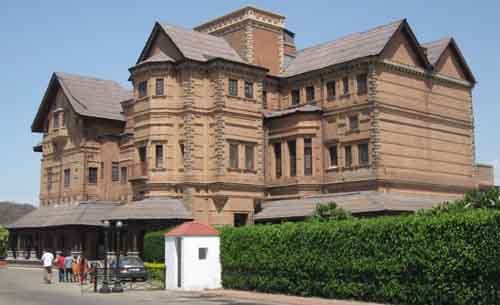Amar Mahal Palace

Information on Amar Mahal Palace (Jammu, Jammu and Kashmir) - History & Architecture
The Amar Mahal Palace is situated in Jammu, the Indian state of Jammu and Kashmir, India. The mentioned structure was actually a palace which was later transformed into a museum. The Amar Mahal Palace was constructed during the period of nineteenth century for a Dogra king, Raja Amar Singh. The palace was designed and built by an architect of French origin in a pattern similar to a French Chateau. The palace was later offered by Dr. Karan Singh to the Hari-Tara charitable trust for using it as a museum. The palace comprises numerous displays which even includes a throne made of gold and weighs 120 kg, a library consisting of 25000 ancient books, Kangra minuscule and Pahari miniscule paintings along with several rare collections of art.
Amar Mahal Palace Architecture
The palace is made of red sandstone along with red coloured bricks and is situated in a striking environment that is on a small hill, commanding a view of the Tawi river valley. The palace was constructed in accordance with the European style of architecture, similar to a castle and therefore, includes slanting roofs with soaring towers. During the reigning period of Raja Amar Singh, the palace used to be amongst the tallest structures in Jammu. The commanding structure has extended passageways which are enclosed with slanting corrugated roofs of tin on the three sides. The passageways are further held up on pillars having wooden framework. The initial storey of the palace structure has French style windows along with linked balcony. The top storey of the palace has a magnificent bay window. The windows of the structure also represent triangular protuberances in conventional Greek architectural pattern, which are fixed on elaborate false columns. The palace was actually designed in the year 1862 and the architecture or rather the design reflected a strong influence of the Queen Anne pattern. Extensive use of stones has been made in order to beautify the palace walls as it appears strikingly different against the backdrop of red coloured bricks. The palace used to be the residence of Raja Amar Singh at a point in time.
Amar Mahal Palace History
The Amar Mahal Palace was designed by an architect of French origin in the year 1862 but, it was not constructed until the period of 1890. The wife of late Maharaja Hari Singh, Maharani Tara Devi used this palace as her residence till the time of her death in the year 1967. Later, Maharani Tara Devi's son Dr. Karan Singh along with his wife named Mrs. Yasho Rajya Lakshmi transformed the Amar Mahal Palace into a rich museum to accommodate exceptional art works and books with the noble intention of promoting artistic flair or aptitude and developing a centre related to fine arts alongside working together with other institutions with similar intentions for the purpose of encouraging and supporting Indian arts. The museum was instated by the late Prime Minister of India, Mrs. Indira Gandhi on 13th of April in the year 1975. Four rooms of the Amar Mahal Palace are kept open or used for displaying Pahari form of paintings related to the heroic scenes of Mahabharata along with royal memorabilia. The museum is known to display the art works of few of the celebrated Indian artists such as J. Swaminathan, Bikash Bhattacharjee, Laxman Pai, M.F. Hussain, G.R. Santosh and Ram Kumar.
Amar Mahal Palace Tourism Importance
The exceptional and unique collection of art works and books in the museum are known to attract art lovers from across the globe. The European architectural pattern of the Amar Mahal palace is also believed to be a crowd puller as well.
- Andaman Nicobar Monuments
- Andhra Pradesh Monuments
- Assam Monuments
- Bihar Monuments
- Chhattisgarh Monuments
- New Delhi Monuments
- Goa Monuments
- Gujarat Monuments
- Haryana Monuments
- Himachal Pradesh Monuments
- Jammu and Kashmir Monuments
- Karnataka Monuments
- Kerala Monuments
- Madhya Pradesh Monuments
- Maharashtra Monuments
- Odisha Monuments
- Punjab Monuments
- Rajasthan Monuments
- Tamil Nadu Monuments
- Telangana Monuments
- Uttar Pradesh Monuments
- West Bengal Monuments